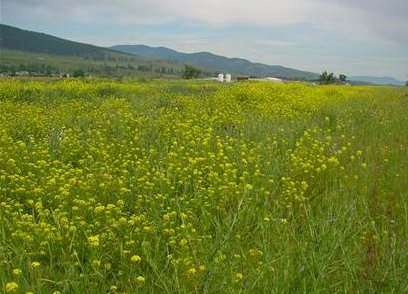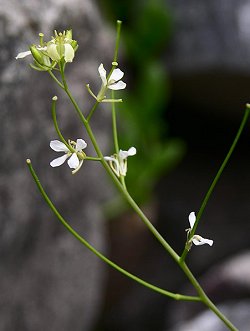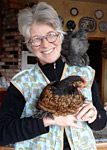home | internet service | web design | business directory | bulletin board | advertise | events calendar | contact | weather | cams

| MUSTARD By Jane Gilbertsen Inside the Deer Fence Dear Methow Gardener, I really appreciate the feedback I have been receiving so if you have any thoughts or comments please let me know. With that in mind, I decided to write on the subject of another weed - MUSTARD. It seems mustard, ours is mostly Sisymbrium altissimum, or tumble mustard or Jim Hill mustard, is on everyone's mind. It is ubiquitious. Our most common mustard is named after the Northern Pacific railroad tycoon James J. Hill. He is reviled by some for bringing thousands out to settle land unfit for farming along the rails. So the mustard bears his name. I guess it is a clue to how people feel about this weed. Why so much this particular year? Well, it seems there might be a couple factors at play. First, the local view...
Now, the global view... Mustard is a C3 weed, as opposed to a C4 or a CAM plant. This designation refers to the 3 carbon-atom molecules of the photosynthetic pathway. C3 plants are considered nonefficient or rather, moving at half-speed literally. What makes them more efficient? More CO2. What do we have these days in our atmosphere? More CO2, actually 25% more following the industrial revolution (fossil fuel use). If you double the CO2 you get about 50% more growth - above ground, below ground and pollen production.
I suppose not too surprisingly, this issue is a major hot button of the global climate change deny-ers and the chemical industry. The crux of the issue is the impact on crops v. weeds of increased atmospheric CO2. Most crops are C3 (42 is the US). Most weeds are C4 (410 for ag in the US) but there are a lot more weeds. The deny-ers argue that if our crops do better with pollution than why worry about it, maybe it is a good thing? Of course, this is pretty simplistic considering the chemical control issues, changes in temperature and rainfall on established and widespread ag crops not to mention our wildlands, and the problems presented by erratic weather, etc. The chemical industry thinks we should just use more chemicals. No problem there either. Sorry for the serious diatribe. On a positive note, the Fulton Ditch Directors will spray the ditch banks after the irrigation season for the poison hemlock. It definitely does not pull out when nestled in the canary reed grass (another weed issue)! My neighbor that allows her horses to graze the ditch banks cut off the flower heads as a partial and temporary solution. It is a start. Every journey starts with a single step. |

 The mustards are cool season broadleaf annuals. They start with a rosette (like the first year Barnaby thistle) and then bolt - shoot up a flowering stalk. They germinate between 32 and 68 degrees, preferably about 50 degrees. They like some water and a little space between rocks, sand or a niche in the soil to hold the seed and water. Each plant can easily produce 12,500 siliques (elongated seed pods) which release a total of 1.5 million seeds. With that production level, only a few need reach favorable conditions to germinate into a mess. We had a wet cool late spring, perfect for mustard germination. Our valley soil continues to be disturbed by road construction, grazing animals both wild and domestic and so on. Mustard is also known for its "morphological plasticity". That means it can take the shape and size the space allows. It can deal with poor nutrients, competition, mowing, traffic, whatever and still grow, flower and set seed. Most grazers avoid it allowing it to grow and set seed amidst grazed down neighbors. It can be killed by herbicides that work for dandelions but those chemicals also kill native wildflowers and shrubs in the nonlawn areas. Handpulling is about it. No biological agents work.
The mustards are cool season broadleaf annuals. They start with a rosette (like the first year Barnaby thistle) and then bolt - shoot up a flowering stalk. They germinate between 32 and 68 degrees, preferably about 50 degrees. They like some water and a little space between rocks, sand or a niche in the soil to hold the seed and water. Each plant can easily produce 12,500 siliques (elongated seed pods) which release a total of 1.5 million seeds. With that production level, only a few need reach favorable conditions to germinate into a mess. We had a wet cool late spring, perfect for mustard germination. Our valley soil continues to be disturbed by road construction, grazing animals both wild and domestic and so on. Mustard is also known for its "morphological plasticity". That means it can take the shape and size the space allows. It can deal with poor nutrients, competition, mowing, traffic, whatever and still grow, flower and set seed. Most grazers avoid it allowing it to grow and set seed amidst grazed down neighbors. It can be killed by herbicides that work for dandelions but those chemicals also kill native wildflowers and shrubs in the nonlawn areas. Handpulling is about it. No biological agents work. What other weeds are C3? Starthistle (a dreaded new invader), cheatgrass (major invader and huge fire starter), quackgrass (our irrigation water is loaded with seeds), lambquarters (at least it is nutritious), knapweed, canada thistle (demonstrating a resurgence from mid 20th Century), narrowleaf plaintain (taking over our irrigated pastures), and bindweed. Studies on the efficacy of Roundup on these weeds under enhanced CO2 shows a dramatic decrease.
What other weeds are C3? Starthistle (a dreaded new invader), cheatgrass (major invader and huge fire starter), quackgrass (our irrigation water is loaded with seeds), lambquarters (at least it is nutritious), knapweed, canada thistle (demonstrating a resurgence from mid 20th Century), narrowleaf plaintain (taking over our irrigated pastures), and bindweed. Studies on the efficacy of Roundup on these weeds under enhanced CO2 shows a dramatic decrease.